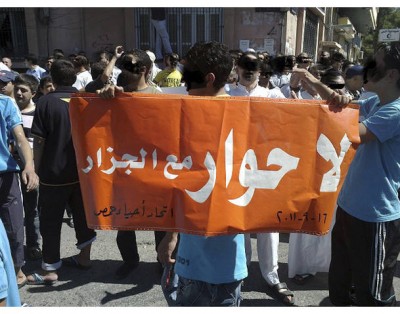
After weeks of bloody siege, Syrian troops have moved into one of the most restive neighborhoods of Homs, one of the cities at the center of the country’s uprising against President Bashar Assad. The Red Cross is preparing to move in, and opposition activists accuse troops of carrying out a scorched-earth campaign of reprisals in the district, called Baba Amr.
Homs is just the latest battleground in one of the bloodiest conflicts to emerge from the region’s Arab Spring revolts. Here are some questions and answers about the uprising.
Q: How many people have died in Syria?
A: The U.N. estimates that more than 7,500 people have been killed since the anti-Assad struggle started in March 2011. Casualty numbers are difficult to track, with groups relying on a mix of activists, citizen journalists, and other sources. Two main activist groups, the British-based Syrian Observatory for Human Rights and the Local Coordination Committees, have put the figure at more than 8,000.
Q: Who are the Syrian rebels?
A: The Syrian rebels lack an organized structure, made up of disparate groups united only on the goal of ousting President Bashar Assad and his regime. They include the tens of thousands of Syrians who have joined in relentless protests around the country, along with the young activists who organize them.
Though the movement started out as peaceful marches, now armed groups have arisen. The Free Syrian Army is the largest armed opposition force, made up of army defectors and protesters who have taken up weapons, but its structure is highly loose. Many act independently under the FSA name. The largest opposition umbrella group, the Paris-based Syrian National Council, is trying to unify the resistance, including forming a military bureau to organize armed groups and funnel weapons.
Q: Why are people fighting against Assad’s regime?
A: The uprising is not just against Assad, but also against his dynasty. His father and predecessor, Hafez Assad, was known for his ruthlessness toward political dissent. In 1982 he suppressed a rebellion by the Muslim Brotherhood in the town of Hama at the cost of roughly 20,000 lives. When his father died in 2000, Bashar was initially welcomed as a more moderate alternative to the iron-fist of his father. But he soon reversed initial reforms and continued the tight grip on power.
When protests initially began nearly a year ago, the opposition only called for reforms, not Assad’s removal. But after the regime launched its bloody crackdown, the opposition moved to demands for his ouster.
Assad retains considerable support, however. The Alawite religious minority, to which he belongs and which makes up the leadership of his regime, has been his fiercest backer, fearing retribution if he falls. The Sunni Muslim majority makes up the backbone of the revolt, but even some in that community — particularly secular and upper-class Sunnis — remain behind Assad, because they worry about chaos and the rise of religious hard-liners without Assad in place.
Q: How did the conflict start?
A: After uprisings toppled regimes in Egypt and Tunisia, the first protests began in Syria’s southern town of Daraa in mid-March after the arrest of schoolchildren who had scrawled anti-government graffiti. Protests began to spread to other parts of the country as Assad’s regime cracked down, opening fire on demonstrators. Since then, the violence has escalated, as the opposition turned more to use of arms and the regime stepped up its retaliation with shelling of neighborhoods. Army defectors and regime forces clash frequently.
Homs, in central Syria, has been one of the main centers of the uprising, particularly in a string of mainly Sunni neighborhoods like Baba Amr.
Q: What are other countries doing to stop the violence in Syria?
A: Attempts by countries to bring an end to the violence in Syria have had limited results. The Arab League sent observers into the country in November but eventually abandoned its efforts after the Syrian government refused to abide by an Arab League brokered peace deal. Proposals for a U.N. resolution have been stymied by the veto power of Assad’s allies Russia and China.
Saudi Arabia and Qatar have been discussing military aid, but the U.S. and others have not advocated arming the rebels, in part out of fear it would create an even more bloody and prolonged conflict. Syria has a complex web of allegiances in the region that extend to Iran and the Lebanese militant group Hezbollah, raising fears of wider violence.
Q: How is information getting out of Syria?
A: The Syrian government has made it difficult for foreign journalists and citizens to show what is happening in Syria. In some cases the Syrian military has directly attacked journalists.
Those journalists whom the regime has allowed in are tightly controlled in their movements by Information Ministry minders. Other foreign journalists sneaked into Syria illegally in the past months with the help of smugglers from Lebanon and Turkey. Several organizations, like New York-based Avaaz, have smuggled cameras and editing equipment to citizen journalists who then upload the videos to YouTube and other sites for use by international media outlets.
The Committee to Protect Journalists says eight journalists have been killed in the last four months in Syria. Among them are award-winning French TV reporter Gilles Jacquier, photographer Remi Ochlik and Britain’s Sunday Times correspondent Marie Colvin. Also, Anthony Shadid, a correspondent for The New York Times, died after an apparent asthma attack while on assignment in Syria.
(This version CORRECTS that The New York Times’ Shadid was not killed in fighting in Syria but died of an apparent asthma attack while on assignment there.)

Leave a Reply
You must be logged in to post a comment.